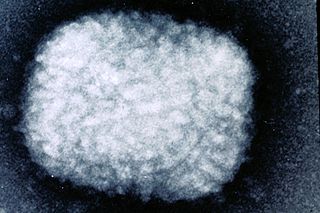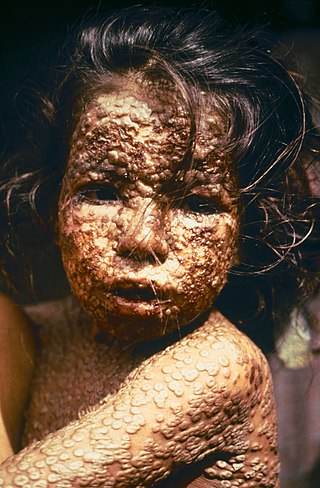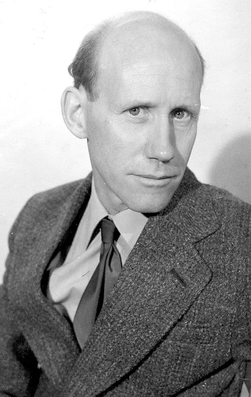Related Research Articles

Cowpox is an infectious disease caused by the cowpox virus (CPXV). It presents with large blisters in the skin, a fever and swollen glands, historically typically following contact with an infected cow, though in the last several decades more often from infected cats. The hands and face are most frequently affected and the spots are generally very painful.

Vaccinia virus is a large, complex, enveloped virus belonging to the poxvirus family. It has a linear, double-stranded DNA genome approximately 190 kbp in length, which encodes approximately 250 genes. The dimensions of the virion are roughly 360 × 270 × 250 nm, with a mass of approximately 5–10 fg. The vaccinia virus is the source of the modern smallpox vaccine, which the World Health Organization (WHO) used to eradicate smallpox in a global vaccination campaign in 1958–1977. Although smallpox no longer exists in the wild, vaccinia virus is still studied widely by scientists as a tool for gene therapy and genetic engineering.

Poxviridae is a family of double-stranded DNA viruses. Vertebrates and arthropods serve as natural hosts. There are currently 83 species in this family, divided among 22 genera, which are divided into two subfamilies. Diseases associated with this family include smallpox.

Camelpox is a disease of camels caused by the camelpox virus (CMPV) of the family Poxviridae, subfamily Chordopoxvirinae, and the genus Orthopoxvirus. It causes skin lesions and a generalized infection. Approximately 25% of young camels that become infected will die from the disease, while infection in older camels is generally more mild. Although rare, the infection may spread to the hands of those that work closely with camels.

Molluscum contagiosum virus (MCV) is a species of DNA poxvirus that causes the human skin infection molluscum contagiosum. Molluscum contagiosum affects about 200,000 people a year, about 1% of all diagnosed skin diseases. Diagnosis is based on the size and shape of the skin lesions and can be confirmed with a biopsy, as the virus cannot be routinely cultured. Molluscum contagiosum virus is the only species in the genus Molluscipoxvirus. MCV is a member of the subfamily Chordopoxvirinae of family Poxviridae. Other commonly known viruses that reside in the subfamily Chordopoxvirinae are variola virus and monkeypox virus.

Frederick William Twort FRS was an English bacteriologist and was the original discoverer in 1915 of bacteriophages. He studied medicine at St Thomas's Hospital, London, was superintendent of the Brown Institute for Animals, and was a professor of bacteriology at the University of London. He researched into Johne's disease, a chronic intestinal infection of cattle, and also discovered that vitamin K is needed by growing leprosy bacteria.
Andrew David Hamilton Wyllie FMedSci FRS was a Scottish pathologist. In 1972, while working with electron microscopes at the University of Aberdeen he realised the significance of natural cell death. He and his colleagues John Kerr and Alastair Currie called this process apoptosis, from the use of this word in an ancient Greek poem to mean "falling off". He completed postdoctoral training in Cambridge University and became Professor of Experimental Pathology at the University of Edinburgh Medical School in 1992. He left Edinburgh for a chair at Cambridge in 1998 where he continued to lecture to undergraduate medical and natural sciences students. His works have contributed to the understanding of apoptosis in health and in disease. Apoptosis is used during early development to eliminate unwanted cells; for example, those between the fingers of a developing hand. In adults, apoptosis is used to rid the body of cells that have been damaged beyond repair. Apoptosis also plays a critical role in preventing cancer. If apoptosis is for some reason prevented, it can lead to uncontrolled cell division and the subsequent development of a tumour.

Smallpox was an infectious disease caused by variola virus which belongs to the genus Orthopoxvirus. The last naturally occurring case was diagnosed in October 1977, and the World Health Organization (WHO) certified the global eradication of the disease in 1980, making smallpox the only human disease to be eradicated.
B-type inclusions, formerly known as Guarnieri bodies are cellular features found upon microscopic inspection of epithelial cells of individuals suspected of having poxvirus. In cells stained with eosin, they appear as pink blobs in the cytoplasm of affected epithelial cells. The absence of Guarnieri bodies cannot be used as to rule out smallpox, however, as more sensitive test need to be performed.
Anthony (Tony) Charles Minson, PhD, FMedSci is a British virologist known for his work on the biology of herpesviruses, and a university administrator. He was the Senior Pro-Vice-Chancellor of the University of Cambridge from 2003 to 2009. He is an emeritus professor of virology at the university's Department of Pathology and an emeritus fellow of Wolfson College.
Dr Lionel Vivian Crawford is a British cancer expert and virologist.
Enzo Paoletti was an Italian-American virologist who developed the technology to express foreign antigens in vaccinia and other poxviruses. This advance led to the development of vaccines against multiple disease-causing pathogens.
Tony Kouzarides, FMedSci, FRS is a senior group leader Gurdon Institute, a founding non-executive director of Abcam and a Professor of Cancer Biology at the University of Cambridge.
Roselyn J. Eisenberg is a professor at The University of Pennsylvania and a member of the University's School of Veterinary Medicine and School of Dental Medicine. The majority of Eisenberg's research is focused on the herpes simplex virus and the poxvirus and how they enter into susceptible cells. She also studies glycoproteins, vaccines, virology and microbiology.
Bernard Moss is a virologist at the National Institute of Allergy and Infectious Diseases, part of the United States National Institutes of Health. He is the Chief of the NIAID Laboratory of Viral Diseases and of the NIAID Genetic Engineering Section. He is known for his work on poxviruses.
Wolfgang Karl "Bill" Joklik was a virologist and James B. Duke Professor Emeritus of Molecular Genetics and Microbiology at Duke University, from which he retired in 1993 after 25 years chairing the department. In 1981, he founded the American Society for Virology, the first scientific society specifically for virologists, and served a two-year term as its founding president. In the same year, he was elected to the United States National Academy of Sciences. He has been described as "one of the earliest molecular virologists" and is best known for his research on poxviruses and reoviruses, and for work on interferon proteins.

Keith Rodney Dumbell was a British virologist who worked on research and eradication of smallpox.
Rijk Gispen, was a Dutch virologist and former Director of the National Institute of Public Health in the Netherlands. He is well known for his research in immunology and the study of Orthopoxviruses.
Charles Bangham holds the Chair in Immunology at Imperial College London.

Henry Samuel Bedson, MD, MRCP, was a British virologist and head of the Department of Medical Microbiology at Birmingham Medical School, where his research focused on smallpox and monkeypox virus. He was head of the smallpox laboratory at Birmingham when Janet Parker, a photographer working above the laboratory, contracted smallpox and died.
References
- 1 2 3 "SMITH, Prof. Geoffrey Lilley" . Who's Who . Vol. 2006 (online Oxford University Press ed.). Oxford: A & C Black.(Subscription or UK public library membership required.)
- 1 2 "Professor Geoffrey L Smith". Contact details. Imperial College London. Archived from the original on 11 July 2009. Retrieved 9 May 2008.
Professor Geoffrey L Smith FRS, FMedSci, FRSB, Wellcome Principal Research Fellow and Chair of Dept: Division of Investigative Science
- 1 2 "Elections". Vacancies, appointments, etc. Vol. CXLI No 22. The Chancellor, Masters and Scholars of the University of Cambridge. 16 March 2011. Retrieved 6 January 2012.
Professor Geoffrey Lilley Smith, M.A., CHR, BSc (Hons), University of Leeds, PhD, CNAA, M.A., Oxford, FRS, FSBiol, FMedSci, Professor of Virology, Imperial College London, and Wellcome Trust Principal Research Fellow, elected Professor of Pathology with effect from 1 October 2011.
{{cite book}}:|work=ignored (help) - 1 2 3 Anon (2003). "Professor Geoffrey Smith FMedSci FRS". London: royalsociety.org. Archived from the original on 17 November 2015. One or more of the preceding sentences incorporates text from the royalsociety.org website where:
"All text published under the heading 'Biography' on Fellow profile pages is available under Creative Commons Attribution 4.0 International License." -- "Royal Society Terms, conditions and policies". Archived from the original on 25 September 2015. Retrieved 9 March 2016.
{{cite web}}: CS1 maint: bot: original URL status unknown (link) - ↑ "Two University Lectureships in Virology and Innate Immunity – Department of Pathology". University of Cambridge. 4 September 2011. Archived from the original on 2 August 2012. Retrieved 6 January 2012.
Following the appointment of Professor Geoffrey Smith FRS as Head of Department and Professor of Pathology from 1 October 2011
- ↑ Society for General Microbiology (2004). Gillespie, Stephen H.; Smith, Geoffrey L.; Osbourn, Anne (eds.). Microbe-vector interactions in vector-borne diseases (Symposium). Cambridge University Press. p. Back Cover. ISBN 978-0-521-84312-6.
- ↑ "Warning over smallpox relative". BBC News. 17 April 2002. Retrieved 3 February 2010.
- ↑ "Should the US and Russia destroy their smallpox stocks?". BBC News. 16 May 2011.
Professor Geoffrey Smith, from Imperial College London … led a review of the state of scientific research on behalf of the WHO
- ↑ Smith, Geoffrey Lilley (1981). Replication of the influenze virus genome (PhD thesis). Council for National Academic Awards. ProQuest 301419558.
- 1 2 Geoffrey L. Smith's ORCID 0000-0002-3730-9955
- 1 2 3 Binns, Matthew M.; Smith, Geoffrey L. (27 May 1992). "The Editors". Recombinant Poxviruses. CRC Press. p. 7. ISBN 978-0-8493-6179-1 . Retrieved 5 February 2009.
Reader in Bacteriology, Sir William Dunn School of Pathology, University of Oxford ... ... in 1985 he returned to the U.K. to a lectureship in Virology in the Department of Pathology, University of Cambridge. ... in 1989 to a Readership in the Sir William Dunn School of Pathology, University of Oxford.
- ↑ "Who's been here | Science and technology". University of Leeds. Archived from the original on 29 March 2009. Retrieved 20 May 2009.
Professor Geoffrey Smith FRS, Biochemistry and Microbiology, 1977
- 1 2 Hogan, Garth (6 June 2012). "2012 GlaxoSmithKline International Member of the Year Award Laureate". American Society for Microbiology . Retrieved 12 June 2012.[ dead link ]
- ↑ Schmeck Jr., Harold M. (19 October 1983). "A Herpes Vaccine Effective in Mice". The New York Times. Retrieved 3 February 2010.
- ↑ "Notes to Editors. Speakers' biographies". Are cures for diseases dangerous weapons? (Press release). ESRC Genomics Policy and Research Forum. 2 April 2007. Archived from the original on 19 April 2013. Retrieved 23 January 2009.
Smith … is the Head of the Department of Virology at Imperial College London. As a postdoctoral fellow in Bernard Moss's laboratory at the National Institutes of Health, USA (1981–84) he developed Vaccinia virus as an expression vector and pioneered the use of genetically engineered viruses as live vaccines
- ↑ Coghlan, Andy; Mackenzie, Debora (17 April 2002). "Fear over camelpox as bioweapon". New Scientist. Retrieved 15 December 2012.
- ↑ "(WO/1998/037217) A Soluble Vaccinia Virus Protein that Binds Chemokines". World Intellectual Property Organization. 27 August 1998.
- ↑ "Former Fellows of the Lister Institute". The Lister Institute for Preventive Medicine. Archived from the original on 7 September 2008. Retrieved 9 May 2008.
- ↑ "Organisation". The Lister Institute. Archived from the original on 3 February 2009. Retrieved 23 January 2009.
- 1 2 "Professor Geoffrey L Smith". Professional Activities. Imperial College. Archived from the original on 14 July 2009. Retrieved 23 January 2009.
- ↑ "Report of the Ninth Meeting" (PDF). WHO Advisory Committee on Variola Virus Research. World Health Organization. 30 November 2007. p. 8. Retrieved 23 January 2009.
The Advisory Committee then elected Professor Geoffrey Smith as chairman
- ↑ Connor, Steve (21 May 2014). "Health experts to vote on whether to destroy the last few samples of smallpox". Independent. Retrieved 23 March 2015.
Professor Geoffrey Smith of Cambridge University, who chairs the WHO's advisory committee on variola virus research, said that he is personally in favour of destroying the virus but that some nations still want the decision deferred until further research has been done.
- ↑ Stockton, Nick (1 May 2014). "The last-ditch effort to save smallpox research". Quartz . Retrieved 23 March 2015.
"My view is that [the drugs] are pretty much done," Dr. Geoffrey Smith of Cambridge University in England told Quartz.
- ↑ "Geoffrey L. Smith". Speakers. Tromsø: GenØk – Centre for Biosafety. Archived from the original on 26 March 2012. Retrieved 6 January 2012.
- ↑ "Cell 'surfing' aids virus spread". BBC News. 22 January 2010. Retrieved 3 February 2010.
- ↑ "Executive Board 2011–2014". International Union of Microbiological Societies. Archived from the original on 4 February 2012. Retrieved 6 January 2012.
- ↑ Cambridge Fund for the Prevention of Disease; Department of Pathology (21 February 2012). Graves, Nicola (ed.). "Welcome Professor Geoffrey L Smith, FRS" (PDF). Pathology News. University of Cambridge (3): 3. Archived from the original (PDF) on 20 May 2012. Retrieved 21 June 2012.
- ↑ Curtis, Polly (19 May 2003). "Royal Society names nine women fellows". The Guardian .
Included in this year's fellows are Professor Geoffrey Smith, known for his research on a smallpox vaccine.
- ↑ "Geoffrey Smith wins Feldburg Foundation Prize". Imperial College London. 13 January 2005. Archived from the original on 24 September 2006. Retrieved 23 January 2009.
- ↑ "Founding Members of the European Academy of Microbiology | Imperial News | Imperial College London".
- ↑ "Prof. Dr. Geoffrey Smith". List of Members. Leopoldina. Archived from the original on 4 March 2016. Retrieved 22 September 2014.
Year of election: 2011
- ↑ "13 neue Leopoldina-Mitglieder erhalten ihre Urkunden" (Press release). Leopoldina. 12 May 2012. Retrieved 22 September 2014.
Die neuen Leopoldina-Mitglieder gehören der Klasse II an, die die Disziplinen der Lebenswissenschaften vereinigt.